Nuku Bimble

|
Rabi Bimble and Thorough
Bimbleabout
 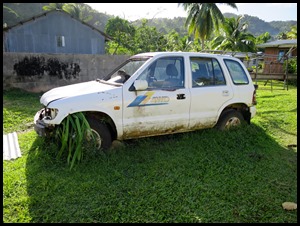 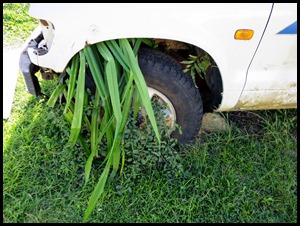 The bus dropped us at the main island
village of Nuku, the first thing we saw was this OCO.
I know, I know, I can hear you saying that it’s a bit
young to be a One Careful Owner, but technically it has a
little rust and quite definitely
growth.
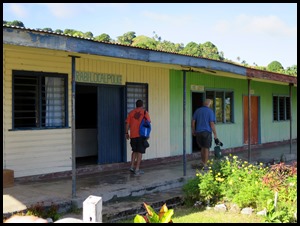  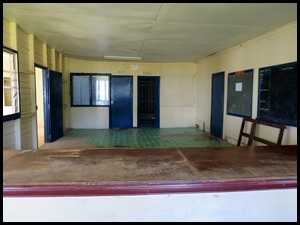 The boys went in
search of officialdom as they had to present boat papers to either a policeman –
Kiribati or Fijian or a town elder. We began at the Police
Station. I bimbled in and was wowed by the
chair – perhaps once a judge sat and did his thing in it ???. The room
was large, the two cells at the back empty – would
loved to have found out the statistics on arrests and confinements but we found
no one.
 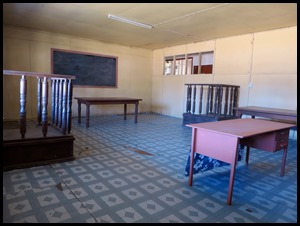  Next door was the
Courtroom – looking right and left, the next door was the Court Clerk, again no one to be
found but the sign on the teddy bear did say ‘how may
I help’, just as I had read the sign a smiling lady appeared and told us the
local policeman was on a visit to the mainland and there was a visiting Fijian
policeman ambling about somewhere, she sent us in the direction of the
Elders.
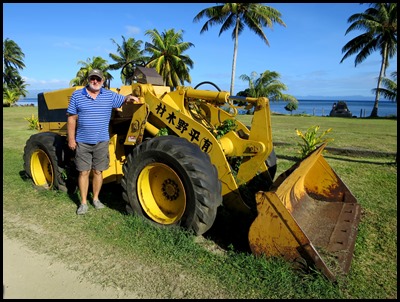 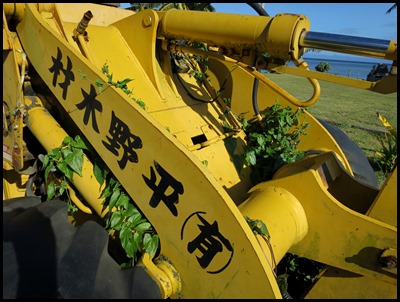 Opposite was
certainly a lady with a view – a gift from China. No
way could I get Bear to climb up into the cockpit so for perhaps the first time
he has failed our dear blog readers...................
 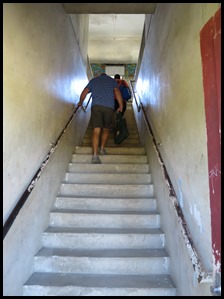 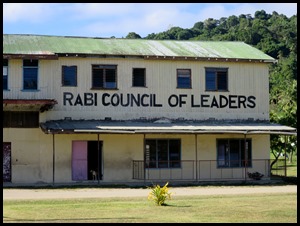 Later, a small person was happy to pose with the lady. The boys disappeared up the stairs to find an official. Maj
and I bimbled over to an outrigger after taking a picture of the Rabi Council of Leaders building.
 A very traditional
vessel.
Why did the people of Banaba find themselves on Rabi Island far from home ??? Wiki says:- The first European sighting of Banaba occurred on the 3rd of January 1801. Captain Jared Gardner in the American vessel Diana sighted the island. Then in 1804, Captain John Mertho of the convict transport and merchant ship Ocean sighted the island and named it after his vessel. Banaba is prone to drought, as it is a high island with no natural streams and no water lens. A three-year drought starting in 1873 killed over three quarters of the population and wiped out almost all the trees; many of those who survived left the island on passing ships to escape the drought, and only some were able to return, often years later. Along with Nauru and Makatea (French Polynesia), it is one of the important elevated phosphate rich islands of the Pacific. Phosphate rock-mining (for fertiliser) from 1900 to 1979 stripped away 90% of the island's surface, the same process which occurred on Nauru from 1907 to the 1980s. Japanese forces occupied the island from the 26th of August 1942 until the end of World War II in 1945. The British authorities relocated most of the population to Rabi Island, Fiji after 1945, with subsequent waves of migration in 1977 and 1981-1983. Some have subsequently returned, following the end of mining in 1979. The population of Banaba in the 2010 census was 295. Globally, there are an estimated 6000 individuals of Banaban descent. On Rabi Island the names of settlements are the same authentic four names from Banaba Island. The woodland of Banaba is now limited to the coastal area and is made up mostly of mangoes, flame trees, guavas, tapioca and common Kiribati shrubs such as the saltbush. Having been mined for over 80 years, the centre of the island has no soil and is uninhabitable. The villages of Tabiang (Antereen), Buakonikai (‘Te Aonoanne’) and Tabwewa are now unoccupied. Banaba had three inhabited villages in the 2010 census; Tabwewa, Antereen (also called Tabiang) and Umwa. Some of the leaders of the displaced Banaban community in Fiji have called for Banaba to be granted independence. One reason given for the maintenance of a community on Banaba, at a monthly cost of four thousand pounds, is that if the island were to become uninhabited, the Kiribati government might take over the administration of the island, and integrate it with the rest of the country. Kiribati is believed to be anxious to retain Banaba, in the hope of remining it in the future. Additionally, along with Kiritimati, it is not a low-lying coral atoll and less susceptible to rising sea levels. There has been so much written about the longest court hearing in history, the financial settlement, the loss of the ships purchased, a generation of men killed by the Japanese [one survived after playing possum and went on to be a witness at the War Crimes Hearings]. Much can be found on www.banaban.com. For us today, we find ourselves amongst lovely, friendly people who love their homeland but are getting on with their lives here on Rabi Island.   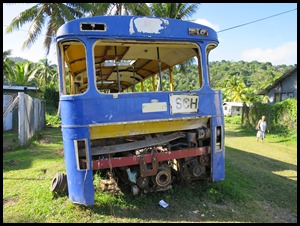   The next corner
saw a bus that hadn’t faired well. Small people, all
smiles but not showing great dental care shouted “mauri” or “hello” and followed
us for a while, chattering away happily.
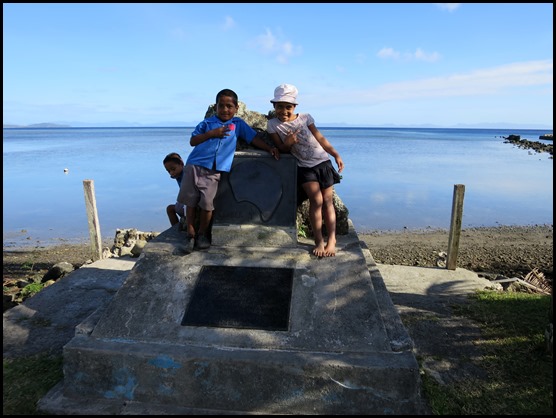 The fiftieth anniversary monument to the arrival of the
first Banabans to the island in 1945.
Rabi was the first place in Fiji where Indian indentured labourers were employed. When the first Indians were brought to Fiji abroad the Leonidas in 1879, most European planters refused to employ them because of the extra cost involved. One planter who was sympathetic to Government policies was Captain J. Hill of Rabi Island, and he agreed to take 106 of indentured labourers as field workers. Prior to the Banaban resettlement on Rabi, the island was owned and used as a copra plantation by the Lever’s Pacific Plantations Pty Ltd. At the beginning of World War II, the British government purchased the island with phosphate royalties from Banaba, in the quest to relocate the Banabans from Banaba. At the end of World War II, Kiribati's (and Fiji's) British colonial rulers decided to resettle most of Banaba's population on Rabi Island, because of the ongoing devastation of Banaba caused by phosphate mining - or, as some would say, to get them out of the way of the mining. Some have since returned, but the majority have remained on Rabi or elsewhere in Fiji. The Banabans came to Fiji in three major waves, with the first group of 703, including 318 children, arriving on the BPC vessel, I-Kiribati. The Banabans had been collected from Japanese internment camps on various islands; they were not given the option of returning to Banaba, on the grounds that the Japanese had destroyed their houses - this was not true. They were told that there were houses waiting for them on Rabi: in fact they were given tents to live in and food rations which lasted for only two months. It was the middle of the hurricane season, and they were still weak from years of Japanese imprisonment: forty of the oldest Banabans died. They were joined by a second wave between 1975 and 1977, with a final wave arriving between 1981 and 1983, following the ending of phosphate mining in 1979. Recognising the lack of opportunities for Banabans in their homeland, the Rabi Council assisted the remaining population to move to Rabi after 1981. On the 15th of December 2005, sixty years to the day since the arrival of the first Banabans, more than five hundred Rabi Islanders were granted citizenship at a ceremony led by Fijian ministers. These islanders, who had not previously been naturalized, came from the second and third waves of migration, which were technically illegal but tolerated by the Fijian government on humanitarian grounds. A decision was made by the Fijian Cabinet in early 2005 to grant citizenship to the residents of Rabi and Kioa Islands, concluding a decade-long quest by the people of both islands for naturalization, which entitles the islanders to provincial and rural development assistance from the government of Fiji. Vosanibola said that although not all of the Rabi islanders had been granted citizenship until now, their contribution to Fiji was enormous, and the government had decided to waive F$1 million of citizenship application fees. These people may be poor by our standards but we see so many riches in their smiles of welcome and their attitudes to working, providing for their families and simply getting on with it. 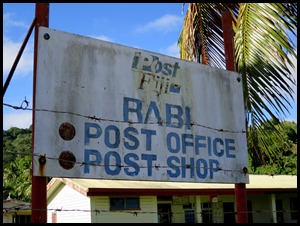 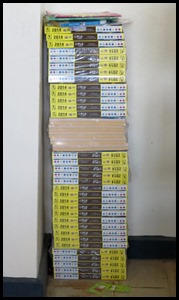 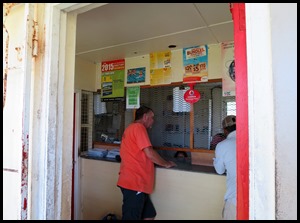 Next stop was the
Rabi Post Office, still wierd to pronounce it Rambi.
We saw a pile of 2014 telephone directories in a neat
pile ready to deliver ???. Steve easily bought a
telephone top up but the lady looked mystified when I asked her for some
stamps.
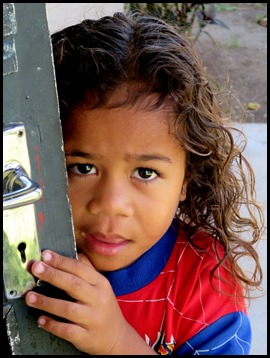 A gorgeous little boy posed for me today – tomorrow an
Armani model.
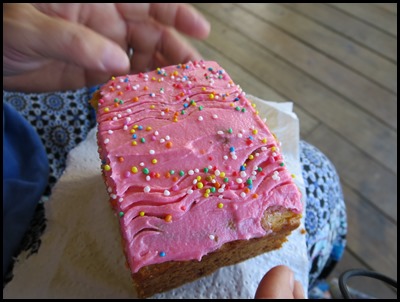 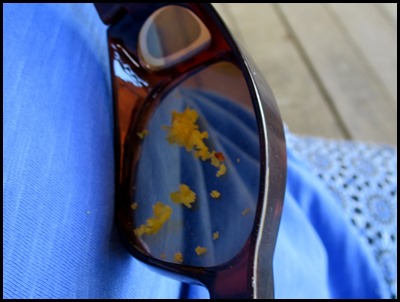 After our tour of
the Coconut Oil Factory – own blog, Bear treated us all to a snack at the towns
refrigeration unit, everyone can bring their labelled food here for cold
storage, buy ice and get a welcome cuppa or lunch. The boys had a piece of lemon
slice, Maj and I shared a huge lump of cake and we
all had a raspberry juice for the princely sum of one pound ten. Maj’s shades came in useful as a pelican
bib.
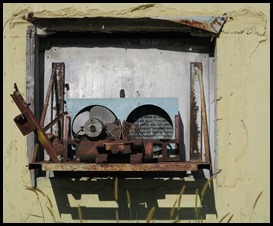 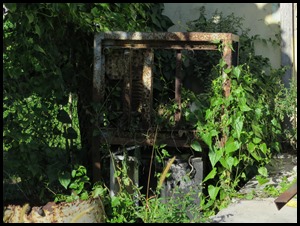 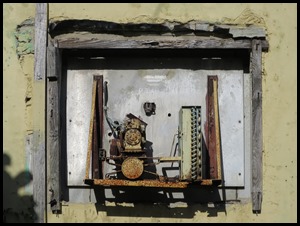 Air-conditioner units on the side of the building next to
us had been once new but not maintained.
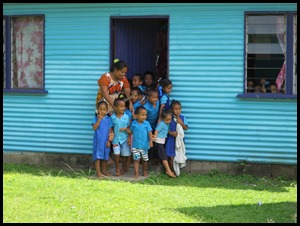 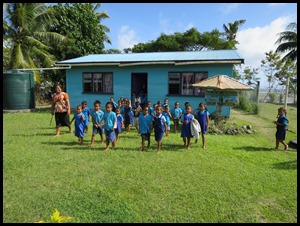 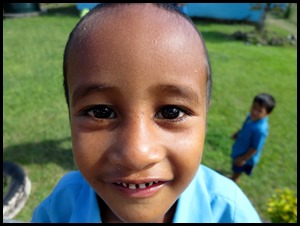 The pre-schoolers saw us and came piling out to say hello, their teacher armed with a small
stick that kept them in order, just the one teacher to this little lot. A lad with equally poor teeth as those on the
bus.
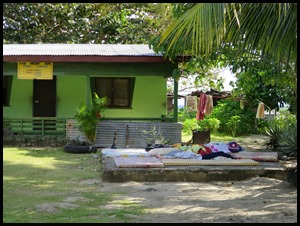  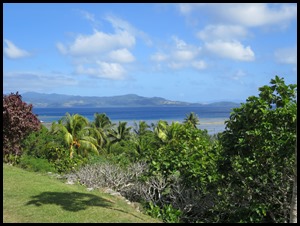 We passed the ‘holiday camp’ alarmed to see mattresses in a poorly
way laying out in the sun. If you want a room you have to check in at the Police
Station and be allotted a room in one of the three exclusive hostelries.......
Wash day outside a typical house en route up the hill
to see the enormous church. From higher up we had a view
across the bay we would sail on the morrow to the north of the island. We
could see people out in the shallows of low tide picking something, no idea
what, will have to find out later.
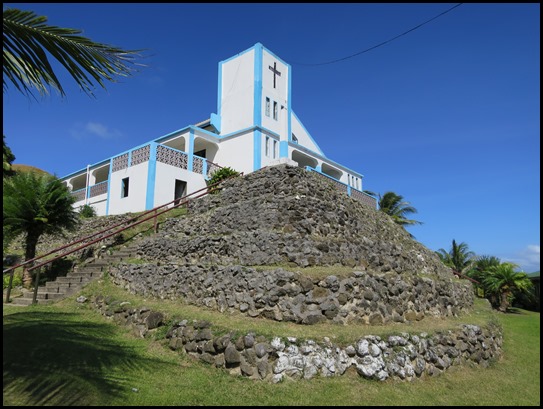 The very impressive
Church.
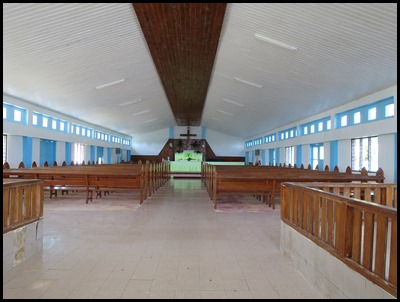 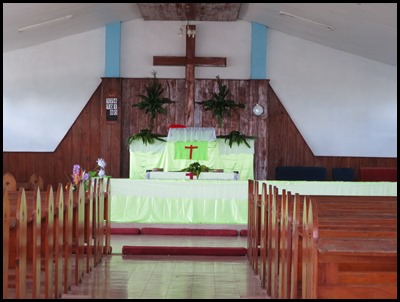 Inside, massive and quaint at the same
time.
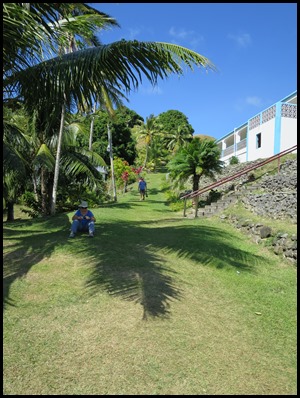 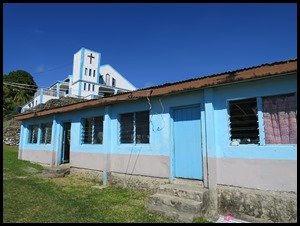  The well kept church grounds. The Community Hall that we saw many mattresses around the
edges. The path down proves that the parishioners
here are made of sturdy stuff.
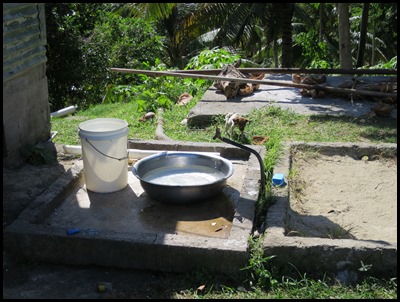 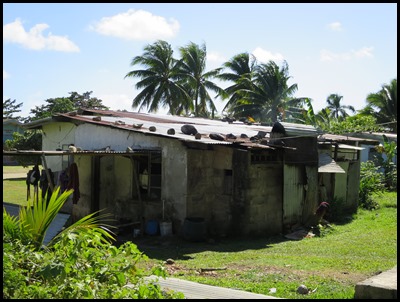 The water supply to a storm-proof house.
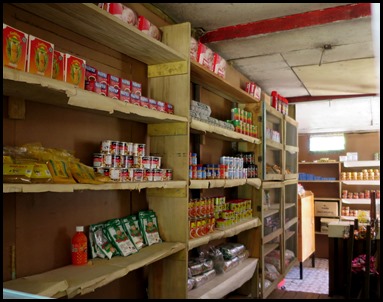 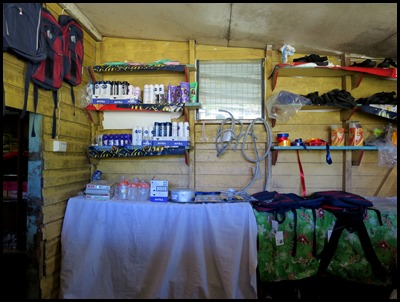 The
supermarket with its ‘home n’ wear’
department.
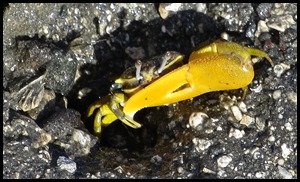   A walk on the pier
and a couple of chaps along the
way.
 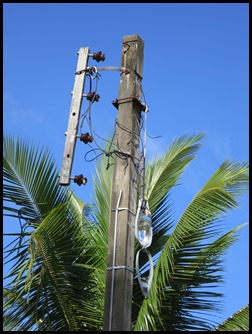 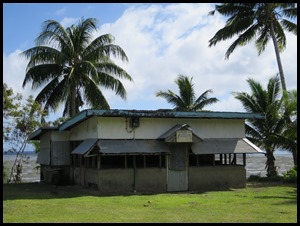 Not sure there was anything more we
could see in the next three hours so we made our way to the pole-seats to wait
for the bus. A lady stopped to show us what was in her bucket. She had been
collecting a seaweed not dissimilar to samphire which she would add an equal
amount of two-minute noodles to and maybe a piece of fish if the menfolk had
been lucky. I think she wanted us to buy an amount but one look at our shivers
and she knew we were not about to comply. We saw the
visiting Fijian policeman doing his community stuff, then he walked over
to talk to us, sadly, his zipper was wide open with no evidence of an under
garment...... and we all have to admit that not one of the four of us ‘put him
right’, instead we averted our eyes to look up at the
lamppost...........all because the fish market
was closed........
 .
ALL IN ALL NOT TO BE
MISSED
A FUN DAY
OUT |